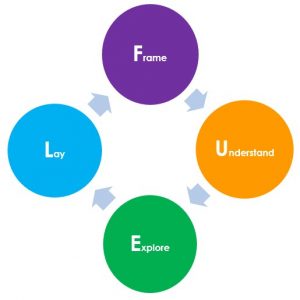FUEL Coaching Model
The FUEL coaching model was developed by John Zenger and Kathleen Stinnett and is detailed in their book “The Extraordinary Coach: How the Best Leaders Help Others Grow.”
FUEL stands for;
- Frame the Conversation
- Understand the Current State
- Explore the Desired State
- Lay out a Success Plan
About the FUEL Coaching Model
With many other coaching models, the coach directs and asks leading questions to guide the individual to what the coach believes to be the best solution. This often results in the individual not being fully vested in the solution and not committing to the plan for resolution.
The FUEL coaching model has the coach asking open-ended, non-leading questions to guide the conversation instead of from telling, directing, instructing, and giving advice. This approach allows the individual to assess the situation, determine their own solution, and take ownership and accountability for the outcome.
Four Steps
The four steps in the FUEL coaching model are:
- Frame the conversation – Set the context and focus for conversation. Agree on purpose, process, and desired outcomes for the discussion.
- Understand the current state – Help the individual gain awareness about their current situation to determine their perspective.
- Explore the desired state – Help the individual to think about and determine their desired state. Generate multiple alternative paths to achieve that desired state.
- Lay out a success plan – Help the individual create a detailed action plan with specific, time-bound steps to be taken to achieve the goal.
FUEL Coaching Model
Frame the Conversation
Framing the conversation means setting the context and parameters of the conversation right at the beginning. You want to get agreement with the individual on;
- the purpose of the conversation
- the process by which you will proceed
- what the desired outcomes will be
In framing the conversation, the coach guides the process, but the individual owns and drives the content.
Suggestions for framing the conversation:
- I would like to discuss ….
- I would like to discuss this because…
- I would like to start by …
- Ultimately, I would like to …..
- During this conversation, I would like to accomplish…
- Is there anything else we should address during this conversation?
- How does that sound to you?
Understand the Current State
In this step, you want to understand how the individual views their current situation. You want to be able to see things from their point of view. Therefore, ask open-ended, non-leading questions to allow a greater insight and clarity into their perspective. This helps reveal any underlying beliefs that may drive the person’s behavior.
Suggestions for asking open-ended questions:
- How do you see this situation?
- What direction do you see this situation going?
- Is this the correct path to continue on?
- Does the situation need to change?
- What is currently working well?
- What are some challenges with that situation?
- What can be improved upon?
- How is this situation impacting you?
- How is this situation impacting others?
- How do you think others may view the situation?
Explore the Desired State
In this step, have the person describe their desired destination. This helps them see what success looks like. The more detailed the description, the more real it is for them. This step also provides you with a vision and understanding of what he or she considers to be their desired state. This vision is the beginning of what will ultimately be the framework for the action plan.
After they have their vision, explore and investigate alternative paths by which they might be able to reach their goal. After, have them prioritize the steps and methods to achieve their vision.
Suggestions for exploring the desired State:
- How do you see your desired state?
- What does that desired state look like?
- What does it feel like to be there?
- What might be some approaches you can take to reach this state?
- What are some other approaches that may work?
- What may be some obstacles to obtaining that desired state?
- What do you need to do first in order to reach that desired state?
Lay Out a Success Plan
In the last step of the FUEL coaching model, the individual needs to formulate a plan of action to achieve their goal. They need to create a detailed action plan with a timetable for accomplishing each of the steps. The plan should be detailed enough to clarify what exactly needs to happen at each step. There should be milestones along the way, and these milestones should have a set time for which they will be achieved. By the individual creating their own action plan, this holds them accountable for the outcome.
Suggestions for developing an action plan:
- What specific actions are necessary to achieve the goal?
- What are some key milestones along the way?
- What is the first step? What is the second step? Then what?
- Do we have all the steps?
- Are the steps in the correct order?
- What are the specific time frames associated with attaining each step?
- How long will it take you to reach those specific milestones?
- Is this plan achievable?
- Do you feel comfortable with the plan?
Additional Links


